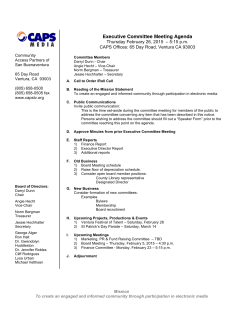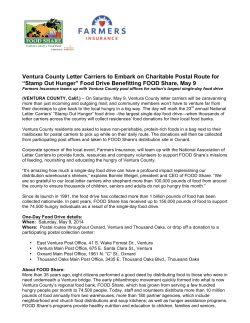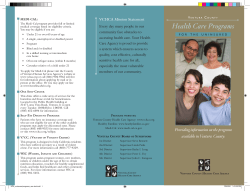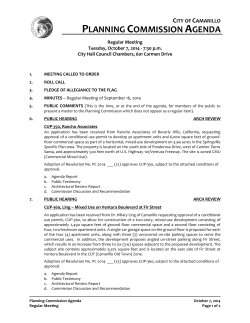
RO/RO Ships Summary
RO/RO Ships Manuel Ventura Ship Design I MSc in Marine Engineering and Naval Architecture Summary • Definition • Types of RO/RO Ships • Profile and evolution of the fleet • Relevant aspects of design – Arrangement of the accesses and garage zone – Cargo types and characteristics – Specific equipment for securing of roll-on/roll-off cargo – Damaged Stability: Criteria and assessment – Safety (SOLAS): Prevention and extinguishing of fire in the garage zone • Annex A. Significant Ships • Annex B. Relevant Non-IMO Standards M.Ventura RO/RO Ships 2 1 RO/RO Ships (1) Roll-On/Roll-Off Ships - ships where the cargo is wheeled or is loaded/unloaded on board in vehicle or platforms equipped with wheels • The first ships of this type were the Ferry, equipped with railways to allow the transport of train carriages between the margins of the rivers that were too wide for bridges • One of the first ferry ships was the Forfarshire, across the Firth of Forth, in Scotland, built in 1861 M.Ventura RO/RO Ships 3 RO/RO Ships (2) • The WWII has motivated the development of this type of ships for the landing of military equipment • After the war many of those military ships were converted for operation as merchant ships, such as the LST (Landing Ship Tank) MV Virginia Beach M.Ventura RO/RO Ships 4 2 RO/RO Ships (3) • The use of the RO/RO concept in merchant ships started in the late 1940’s, early 1950’s, mainly in short-sea routes M.Ventura RO/RO Ships 5 Types of RO/RO Ships • • • • • Ferries Freight Ro-Pax Pure Car Carriers Combined carriers – Container Ro/Ro – Ro/Ro Lo/Lo M.Ventura RO/RO Ships 6 3 Ferry Cariiage of Passengers and Vehicles M.Ventura RO/RO Ships 7 Ferry – Typical General Arrangement M.Ventura RO/RO Ships 8 4 Freight Ro/Ro Transport of Wheeled Cargo M.Ventura RO/RO Ships 9 Ro-Pax Mixed Transport of Passengers, Vehicles and Wheeled Cargo M.Ventura RO/RO Ships 10 5 Pure Car Carrier (PCC) Car Transport • Ships quite sensitive to the side winds due to the large exposed area • Present a large number of ventilators on the exposed deck due to the SOLAS requirements for the garage zove The largest PCC currently in service is the MV Mignon (1999), from Wallenius Lines, which after a lengthening of 28 m (2005) has the capacity to carry about 7,200 cars. M.Ventura RO/RO Ships 11 Pure Car Truck Carrier (PCTC) Transport Cars and Trucks Loa = 198 m Lpp = 188 m B = 32.20 m D = 14.60 m T = 8.80 m DW = 16,957 t Courageous Ace (2003) 6400 cars M.Ventura RO/RO Ships 12 6 Container Ro/Ro (ConRo) Combined Ship, Container Carrier and Ro/Ro ConRo Trader (1978) Loa = 109.60 m DW = 4,550 t Generally carries stacks of containers on the upper deck and wheeled cargo under deck M.Ventura RO/RO Ships 13 Ro/Ro Lo/Lo CEC Oceanic (1997) Loa = 100.90 m DW = 5,150 t Ship that can carry and load wheeled cargo, but that also has lifting equipment to load/unload through the hatches M.Ventura RO/RO Ships 14 7 Profile and Evolution of the Fleet World Fleet of Ro/Ro Ships 2005 World Fleet Added to Fleet April Jul. 8172 7522 70 32 2006 Oct. Jan. April 7520 6754 6823 19 36 36 Change [%] Jul. Prev. Period Same period prev. year 6865 0.6 -8.7 54 48.5 65.6 Notes: • Only Ro/Ro cargo ships • Units: [1,000 tdw] Source: ISL Market Review 2006 – Merchant Fleet Data M.Ventura RO/RO Ships 16 8 Recent Evolution of the Fleet No. Ships 2002 [%] Tot 1,000 GT [%] Tot 1,000 DWT [%] Tot 1,000 TEU [%] Tot [%DWT] 0.9 Jan. 1128 2.9 10,628 2.0 7,365 0.9 301 4.1 Jul. 1137 2.9 10,888 2.0 7,459 0.9 301 3.9 1.3 2004 Jan. 1239 3.0 12,246 2.1 8,171 1.0 311 3.6 9.6 Jul. 1235 3.0 12,597 2.2 8,224 1.0 319 3.6 0.7 2005 Jan. 1215 3.0 12,896 2.1 8,301 0.9 318 3.4 0.9 Jul. 1258 2.9 10,960 1.8 7,522 0.8 301 3.1 -9.4 2006 Jan. 1296 2.8 9,559 1.5 6,754 0.7 273 2.6 -10.2 Jul. 1302 2.9 9,747 1.5 6,865 0.7 275 2.5 1.6 Source: ISL Market Review 2006 – Merchant Fleet Data M.Ventura RO/RO Ships 17 Evolution of the Capacity Ro/Ro 1,000s lane metres 2003 2006 Absolut Growth Intra European NW 522 573 + 51 Intra Mediterranean 394 447 + 53 27 60 + 33 108 109 +1 Intra Asian (exc. ferries) Intra Americas Inter-continental Total all routes • • 199 222 + 23 ____ 1291 ____ 1473 _____ + 182 Global growth of abt. 14% in 3 years Increase of capacity concentrated in established markets M.Ventura RO/RO Ships 18 9 Comparison of Ships Ro/Ro Cargo - RoPax • Increasing trends to build RoPax ships – Market of passenger ferries declining due to the low cost air transport companies – RoPax ships present a larger increase in the intra-European low cost transport Capacity of service (lane metres) Ropax Only Cargo 2003 2006 Change 185 235 + 27% 67 74 + 10% Source: MDST Containership Databank M.Ventura RO/RO Ships 19 World Fleet – Evolution of the Orders M.Ventura RO/RO Ships 20 10 Arrangement of Access Way and Garage Zones Dimensions of Access Ways M.Ventura RO/RO Ships 22 11 External Access Ramp Ramp angle < 12º M.Ventura RO/RO Ships 23 Internal Access Ways • • Capacity expressed in total lane length Parking space requirements: Cars Trucks length [m] width [m] height [m] * Load [t/axis] 4.0 ~ 5.5 2.2 ~ 2.5 2.0 1.0 10.0, 12.0, 15.0 2.8 ~ 3.1 4.7 15.0 (double wheels) 12.0 (single wheels) (*) Minimum free height, must add margin for upper deck structure M.Ventura RO/RO Ships 24 12 Parking Spaces • For road trailers, semi-trailers and roll trailers the width of the lane is typically 2.90 m • The width of the cargo space should be a multiple of 2.90 m M.Ventura RO/RO Ships 25 Internal Ramps • The slope of the internal ramps is normally between 1 :7 to 1 : 10 (abt. 8° – 6°) and the width should be carefully selected in relation to the cargo stowed at each deck. • Widths between 7 and 12 meters are used in the large ships • Anti-skid surfaces are important. M.Ventura RO/RO Ships 26 13 Initial Dimensioning Guidelines Length Estimate • Ro/Ro Cargo Ships Lpp = 110 + (Lm − 1000) / 25 Lm = Lane length [m] Ncars = max. Number of cars • Ro/Ro Passenger Ships Lpp = 30 + (Ncars - 15)x(10/17) Ncars < 100 Lpp = 80 + (Ncars - 100)x(5/22) 100 < Ncars < 320 Lpp = 130 + (Ncars - 320)/9 320 < Ncars < 500 Lpp = 150 + (Ncars - 500)/10 Ncars > 500 Kristensen, Hans Otto (2006), “Cargo Transport by Sea and Road – Technical and Economical Environmental Factors, Naval Engineers Journal, Vol.118, No.3. M.Ventura RO/RO Ships 28 14 Typical Midship Section Configurations Shortsea Ro/Ro Overseas Ro/Ro M.Ventura RO/RO Ships 29 Deck Configuration • The number of decks increases with ship size. • For ships up to about 15000 tdw, 2 decks are most common. • Bigger ships have often 3 permanent decks. • Movable car decks are frequently installed in between the permanent decks. M.Ventura RO/RO Ships 30 15 Ro/Ro Deck Configurations (1) M.Ventura RO/RO Ships 31 Ro/Ro Deck Configurations (2) M.Ventura RO/RO Ships 32 16 Trailers – Stowage in Lanes Ro/Ro for Carriage of Trailers (Semi-Reboques) - Stowage M.Ventura RO/RO Ships 33 Cargo Equipment for Ro/Ro Ships 17 Cargo Equipment for Ro/Ro Ships (1) RO/RO ships require a wide range of access equipment. M.Ventura RO/RO Ships 35 Stern Ramp Configurations M.Ventura RO/RO Ships 36 18 Cargo Equipment for Ro/Ro Ships (2) • • • • Bow doors Bow ramps Internal doors Hoistable car decks • Hoistable car ramps M.Ventura RO/RO Ships 37 Ramps/Bow Access Doors • Stern ramps, for ships that attend Ro/Ro terminals M.Ventura RO/RO Ships 38 19 Ramps/Stern Access Doors Quarter ramp, which allows access with the ship in a peer (without Ro/Ro terminal) M.Ventura RO/RO Ships 39 Ramps/Bow Access Doors • Bow ramp “Folding Frame Type” • Allows a complete separation of the door in the collision bulkhead from the remainder of the ramp www.tts-marine.com M.Ventura RO/RO Ships 40 20 Bow Ramp Folding Frame Type Opening sequence of the bow ramp. M.Ventura RO/RO Ships 41 Side Shell Doors M.Ventura RO/RO Ships 42 21 Internal Ramps Internal ramps typically have inclination of abt. 7° M.Ventura RO/RO Ships 43 Internal Doors Watertight door designed for the subdivision of the cargo spaces with a minimum of interference M.Ventura RO/RO Ships 44 22 Movable Car Decks • Intermediate decks of lightweight construction that allow the stowage of cars inside the deck for heavy vehicles M.Ventura RO/RO Ships 45 Moveable Car Decks • There are 2 types of moveable car decks: – Hoistable Car decks – with integrated lifting device, electrically or hydraulically driven – Liftable Car Decks - do not have integrated lifting mechanism, they are moved by lifts of the scissors type Hoistable Car Deck Liftable Car Deck M.Ventura RO/RO Ships 46 23 COREX Cardecks • Stainless steel sandwich panels from MacGreggor • A 3D truss-core is built-up between top and bottom panels • Compared with conventional steel cardecks they have about 1/3 of the depth and about ½ of the weight M.Ventura RO/RO Ships 47 Cargo Lifts • Lifts to carry vehicles between decks, in ships where the longitudinal space is limited • There are configurations in which the platform itself works as watertight hatch cover when secured in its lower position • Types of cargo lifts: • Scissors • Telescopic • Chain driven M.Ventura RO/RO Ships 48 24 Cargo Handling MAFI Trailer Used to move containers on chassis in the terminals Connection System M.Ventura RO/RO Ships 49 MAFI Tractor M.Ventura RO/RO Ships 50 25 Tugmaster Terminal Tractor Goose neck M.Ventura RO/RO Ships www.kalmarind.se 51 Roll Trailers M.Ventura RO/RO Ships 52 26 Truck and Semi-Trailer Overall Height 4.15 m Semi-Trailer Overall Width 2.6 m Length 16.2 m Overall Length 23.0 m Width 2.5 – 2.6 m Truck Tractor Wheelbase 6.2 m Tandem axle spread 1.2 m M.Ventura RO/RO Ships 53 Semi-Trailers Trailer horse M.Ventura RO/RO Ships 54 27 Trailer Trestle • A terminal trailer trestle is a device which releases the towing truck for more productive use while the semi-trailer is loaded or unloaded in a terminal. M.Ventura RO/RO Ships 55 Cassettes for Containers • • • The cassettes are detachable steel platforms, which containers can be loaded on for transporting. The containers can be doublestacked so that either 2x40ft or 4x20ft containers can be moved. This cassettes are able to handle 80 tons (there are examples of120-ton versions used in the steel industry). One of the advantages of using cassettes is that they act as a “floating” buffer, since containers can be placed on the cassettes with or without being coupled to a vehicle. M.Ventura RO/RO Ships 56 28 Cassettes cassette M.Ventura translifter RO/RO Ships 57 Translifter • A translifter is a steerable lifting trailer which can be used with pallets or trestles • It has soft wheels www.ttsgroup.com M.Ventura RO/RO Ships 58 29 Types of Cargo (1) • Road Trailer Including tractor and the trailer with the container on top. The dimensions, including allowances, are 12.5 m x 3.0 m x 4.5 m. Weight of 30 – 35 t and centre of gravity at 3.0 m height. Load: 15.0 t/axle, 1.3 m distance between axis. • MAFI trailer Platforms for cargo towing, moved by tractors designated byTugmasters. Load: 18.0 t/axle, 0.7 m distance between axis. • Tugmaster Tractor for moving cargoes in the terminals and in the ship. Load: 21.0 t/axle. M.Ventura RO/RO Ships 59 Types of Cargo (2) • PaletteRectangular shaped structure where the cargo is stowed. Many different sizes, with rectangular shapes whose sides vary in a range from 0.8 m to 1.5 m. The size currently more used is 1.25 m x 1.0 m. The height of the cargo depends from the stowage conditions but can be assumed a value of 1.8 m to 2.0 m from the base, including the pallette. • Car Change a lot, but for European cars, average values of 4.5 m x 2.0 m x 1.7 m can be assumed, with an average weight of 1.0 t and max. of 2.0 t. • SECU (Storabox unit) specialized container for the carriage of paper, with dimensions 13.8 m x 3.6 m x 3.6 m and weight of 90t. M.Ventura RO/RO Ships 60 30 Types and Characteristics of Cargo (1) Cargo Type Length [m] Width [m] Height Max. [m] Weight Max. [t] Load/ axis [t] Slope Max. [%] Speed Max. [km/h] Contentor 20’ 9.0 3.2 4.4 57.0 54.0 12.5 30 Paletes 4t 4.0 1.3 2.2 10.0 8.0 16.0 30 Truck 11.0 2.5 4.4 24.0 10.0 16.0 80 Truck (articul.) 15.0 2.5 4.4 38.0 10.0 16.0 80 Trailer 20’ 6.1 2.5 4.5 22.0 10.0 14.0 80 Trailer 40’ 12.3 2.5 4.5 35.0 10.0 11.0 80 4.0 1.6 1.4 2.0 1.0 20.0 100 Car EU M.Ventura RO/RO Ships 61 Types and Characteristics of Cargo (2) Cargo Type Length [m] Width [m] Height Max. [m] Weight Max. [t] Load/ axis [t] Slope Max. [%] Speed Max. [km/h] Wagon w/ container 40’ 14.0 4.7 3.4/6.0 52.0 2 x 13.0 14.0 15 Tractor LUFmaster 8 TEU/ 2 layers 18.8 4.9 5.9 247.0 48.0 11.0 15 Side carrier 1 TEU 9.0 3.7 4.6 60.0 30.0 14.0 30 Straddle carrier 1 TEU 6.0 3.9 4.5 40.0 10.0 11.0 30 M.Ventura RO/RO Ships 62 31 Vehicle Securing IMO Guidelines – Securing Points • Guidelines for Securing Arrangements for the Transport of Road Vehicles on Ro-Ro Ships. • Apply to Ro-Ro ships which carry road vehicles on either long or short international voyages in unsheltered waters • Are applicable to: – Road vehicles with an authorized total mass of vehicle and cargo between 3.5 and 40 t – Articulated road trains with an authorized total mass not more than 45 t • The decks shall be provided with securing points with: – Longitudinal spacing < 2.5 m – Transverse spacing 2.8 < S < 3.0 – Minimum strength without permanent deformation: 20 KN M.Ventura RO/RO Ships 64 32 Securing Points on Decks M.Ventura RO/RO Ships 65 Securing Points on Decks (Cars) M.Ventura RO/RO Ships 66 33 IMO Guidelines – Lashing • Lashing shall consist of chain or any other device made of steel or other material with equivalent strength and elongation characteristics • The strength of lashing without permanent deformation should not be less than 120 KN • Lashings should be attached to the securing points with hooks or other devices • Lashings should only be attached to the secure points • The angle between the lashings and the horizontal and vertical planes shall be preferably between 30° and 60° M.Ventura RO/RO Ships 67 Car Lashing Equipment M.Ventura RO/RO Ships 68 34 Trailer and Truck Lashing Chain lashing M.Ventura RO/RO Ships Web lashing 69 Accidents due to Improper Lashing Accident due to an articulated vehicle being only lashed at the 4 corners (www.shipownersclub.com) M.Ventura RO/RO Ships 70 35 Aspects of Hull Structural Design Scantlings of Decks for Wheeled Cargo (BV) The thickness of plate panels submitted to wheeled cargoes shall no be less than the following, in [mm]: with: M.Ventura RO/RO Ships 72 36 Scantlings of Decks for Wheeled Cargo (BV) When the tyre print area, AT, is not known, can be used the value in [m2] computed by the expression: with: n – number of wheels on the plate panel QA – load in t/axis nW – number of wheels in the axis considered PT – pressure of the tyres [kN/mm2] (When the value is knot known, use the ones from Table 6) M.Ventura RO/RO Ships 73 Scantlings of Decks for Wheeled Cargo (BV) with: In the vehicles where the 4 wheels of the axis are on the plate panel (Figure 1) the plate thickness shall be the largest of the values obtained from the following expressions: M.Ventura RO/RO Ships 74 37 Damaged Stability Accidents with Ro/Ro Ships • Princess Victoria (1953), 135 casualties Herald of Free Enterprise (1987), 193 casualties Estonia (1994), 852 casualties M.Ventura RO/RO Ships 76 38 Damaged Stability (1) • • • • • The shipwreck of the “Harald of Free Enterprise”, in 1987, called the attentions for the damaged stability of Ro/Ro ships, which are characterized for NOT having watertight subdivision above the main deck In a first approach R&D has focused on the residual stability of existing ships and in the identification of the main causes of the shipwrecks The sinking of the “Estonia” has increase the urge to find solutions Measure of Survivability – Critical height of the water on deck. Based in probabilistic concepts. The total probability of survival has 2 factors: – The probability that a given compartment is flooded – The probability that the ship survives to that flooding M.Ventura RO/RO Ships 77 Damaged Stability (2) • The probability of survival can be divided in 2 factors: – The probability of surviving the pure lost of stability, moments of heel, displacement of the cargo and angle of heel – The probability of surviving the effect of the water accumulated on deck due to the action of the waves • The computation of this last factor designated by survival factor with water on deck, sW, is based in the concept of the critical height of the wave at which capsize (sossobrar) occurs, and so sW is just the probability that this wave height is not exceeded M.Ventura RO/RO Ships 78 39 Static Equivalent Method (SEM) • Based on the results from experimental tests it was determined that the capsizing happens at an heeling angle close to ΘMax, the angle corresponding to the maximum value of the righting moment • ΘMax is determined by the traditional constant displacement method, allowing the progressive flooding of the car deck until the immersion of the deck at side • Based in these assumptions, it was developed the Static Equivalent Method (SEM), that allows the calculus of the critical amount of water accumulated on deck from the results of static stability computations M.Ventura RO/RO Ships 79 Static Equivalent Method • It is considered a flooding scenario in which the ship has a only a damage under the car deck, but there is a quantity of water accumulated on the deck, considered intact • The critical amount of water is the one that takes the ship to assume an equilibrium heeling angle equal to ΘMax with: hcrit – difference in height between the internal and external waterlines HScrit – critical significative wave height M.Ventura RO/RO Ships 80 40 Safety – Impact of SOLAS Fire Prevention and Extinguishing • In Ro/Ro ships, the closed decks for wheeled cargo shall have levels of protection equivalent to machinery spaces – Must be limited by class A boundaries (in steel or equivalent material) – Closed spaces to be protected by a fixed fire extinguishing system, typically CO2 in cargo ships and sprinklers (DeLuge system) in car ferries – Smoke detection system – Open cargo decks do not require a fixed fire extinguishing system – Portable systems and hoses M.Ventura RO/RO Ships 82 41 Ventilation of Cargo Spaces for Vehicles • The ventilation system of the cargo spaces shall be completely segregated from the others ventilation systems • In ships with a number of passengers <N>, the system shall guarantee – N > 36 -> 10 renewals/hour – N ≤ 36 -> 6 renewals/hour Source: SOLAS Chap. II-1 Regulation 38 – Cargo Spaces for Motor Vehicles M.Ventura RO/RO Ships 83 Conclusions from the Analysis of the Fires • In accordance to SOLAS, the large fires are rare in ships and the casualties are generally related with situations when the passengers are in the interior of the vehicle during the voyage (which is no longer acceptable by SOLAS and by the ISM code) • Many of the big fires started when the ship is in port, during load or unload. The detection system is often temporarily switched off and the CO2 can not be released quickly by the system because the ramps (internal and external) are still open • The reliability of the low pressure CO2 systems for cargo space is generally quite low • The sprinkler systems for Ro/Ro decks in Ferries have shown good results Source: DNV, “Fires on Ro-Ro Decks”, DNV Technical Paper, 2005 M.Ventura RO/RO Ships 84 42 Fires in Ro/Ro Ships (1990-2003) Source: DNV, “Fires on Ro-Ro Decks”, DNV Technical Paper, 2005 M.Ventura RO/RO Ships 85 Fires in Ferries (1990-2004) Source: DNV, “Fires on Ro-Ro Decks”, DNV Technical Paper, 2005 M.Ventura RO/RO Ships 86 43 Bibliography (1) • Boulougouris, V., Papanikolaou, A., Zaraphonitis, G., “Optimization of Arrangements of Ro-Ro Passenger Ships with Genetic Algorithms”, Journal Ship Technology Research, Vol. 51, No. 3, 2004. 9 DNV, “Guidelines - Design and Classification of Roll On/Roll Off Ships”, 1988. • DNV, “Fires on RoRo Decks”, DNV Technical Paper, 2005 9 Kreuzer, E.; Schlegel, V. and Stache, F. (2007), "Multibody Simulation Tool for the Calculation of Lashing Loads on RoRo Ships", Journal of Multibody System Dynamics, Vol.18, No.1, August, 2007. (CD-ROM#52) 9 Krinstensen, Hans Otto (2006), “Cargo Trasnport by Sea and Road Technical and Economical Envoronmental Factors”, Naval Engineers Journal, Vol.118, No.3. (CD-ROM#83) M.Ventura RO/RO Ships 87 Bibliography (2) • Papanikolaou, A., Spanos, D., Boulougouris, E., Eliopoulou, E., Alissafaki, A., “Investigation into the Sinking of the Ro- Ro Passenger Ferry Express Samina”, Journal International Shipbuilding Progress, Vol. 51, No. 2, 2004. 9 Ravn, Erik Sonne (2003), “Probabilistic Damaged Stability of Ro/Ro Ships”, PhD Dissertation, Technical University of Denmark. • Turnbull, Stuart R. (2004), “Roll-on/roll-off semi-trailer models: a comparison of results”, Journal of Marine Science and Technology, Vol.5, No.3, Feb. 2004, pp. 101-106. • Vassalos, D., Papanikolaou, A., "Stockholm Agreement - Past, Present, Future (Part 1)", Journal Marine Technology, Vol. 39, No. 3, July 2002, pp. 137-158. • Vassalos, D., Papanikolaou, A., "Stockholm Agreement - Past, Present, Future (Part 2)", Journal Marine Technology, Vol. 39, No. 4, Oct. 2002, pp. 199-210. M.Ventura RO/RO Ships 88 44 Relevant IMO Guidelines and Codes • IMO Resolution A.533(13) - Elements to be taken into account when considering the Safe Stowage and Securing of Cargo Units and Vehicles in Ships 9 IMO Resolution A.581(14) (1985) - Guidelines for Securing Arrangements for the Transport of Road Vehicles on Ro-Ro Ships. 9 IMO MSC.1/Circ.1355 (2010) - Amendments To The Guidelines For Securing Arrangements For The Transport of Road Vehicles on Ro-Ro Ships (Resolution A.581(14)) • IMO Resolution A.714(17) (1991) Code of Safe Practice for Cargo Stowage and Securing (CSS Code) M.Ventura RO/RO Ships 89 Relevant Links Suppliers of Ro/Ro Equipment • www.macgregor-group.com • www.nordana.com • www.tts-technology.no Other • www.shipownersclub.com M.Ventura RO/RO Ships 90 45 Annex A. Significant Ships Ro/Ro Ferry (1) M.Ventura RO/RO Ships 92 46 Ro/Ro Ferry (2) M.Ventura RO/RO Ships 93 Ro/Ro Ferry (3) M.Ventura RO/RO Ships 94 47 Ro/Ro Ferry (4) M.Ventura RO/RO Ships 95 Tor Petunia M.Ventura RO/RO Ships 96 48 MV Tamesis M.Ventura RO/RO Ships 97 Annex B. Relevant Non-IMO Standards 49 Some Relevant ISO Standards • ISO 9367-1:1989 - Lashing and securing arrangements on road vehicles for sea transportation on Ro/Ro ships -- General requirements -- Part 1: Commercial vehicles and combinations of vehicles, semi-trailers excluded • ISO 9367-2:1994 - Lashing and securing arrangements on road vehicles for sea transportation on Ro/Ro ships -- General requirements -- Part 2: Semi-trailers M.Ventura RO/RO Ships 99 50
© Copyright 2025









